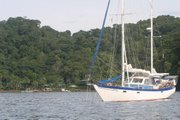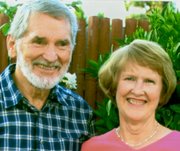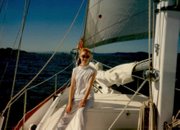Back aboard, we prepared for the next short leg of our passage to Panama City, an overnight stop at Garachiné, farther up the Darién coast. At start-up, we had no start-up. The starter had stuttered a couple of times recently, but this time it showed no signs of life. Bob did his troubleshooting, concluding the solenoid was probably failing. He tapped on the housing with a hammer while I gave the starter button short bursts. It fired up, and we were off.
The Darién coast is splendid from the water, with lush green hills and the occasional waterfall pouring into the ocean, reminding Bob of the rainy coasts of the Big Island, though the falls were much shorter. An occasional small village occupied a small cove, but largely the coast is a primitive luxuriance of green, with white water exploding on black rocks on its shores.
The other notable natural phenomenon reminded us of our cruising in another part of the world, the Pacific Northwest to Alaska. As we were passing Roca Guajala, about 1 mile off the Darién coast, the seas became abruptly and increasingly tumultuous. Our depth sounder as abruptly dropped from 85 feet to under 10, then down to 6 (the depth Carricklee draws). Had we encountered an uncharted reef? We could see no other reason for such turbulence and change of depth. Most unnerving. We headed straight out to sea and soon were out of the Mixmaster.
Then we had time to analyze the conditions. It seemed exactly like one of the several narrow straits in Canada and Alaska, where the 20+-foot tides push such volumes of water through the straits that even the largest of ship avoids navigating these straits at any time other than slack water. As for the shallowness, Bob surmised the extreme turbulence was sending the new and apparently highly sensitive depth sounder a false reading. But what we can’t explain is what created such turbulence on the sea side of a single rock.
In minutes we were safely around Punta Garachiné and into a small cove of Golfo de San Miguel, this “lake” in which we’d anchored so still we were each up at various times throughout the night to check to see if we were aground. But we were always in 20-26 feet of water.
The next morning we had more time to contemplate the steep, green-shrouded cliffs surrounding this lake. We were up at 0600, listening to the sounds of the jungle, those reverberant sounds we first heard in the jungle movies of our youth, indescribable but always recognizable. But we saw only the quietly busy black-headed vultures and one lone cattle egret.
Thursday, November 30, 2006
Subscribe to:
Post Comments (Atom)






No comments:
Post a Comment